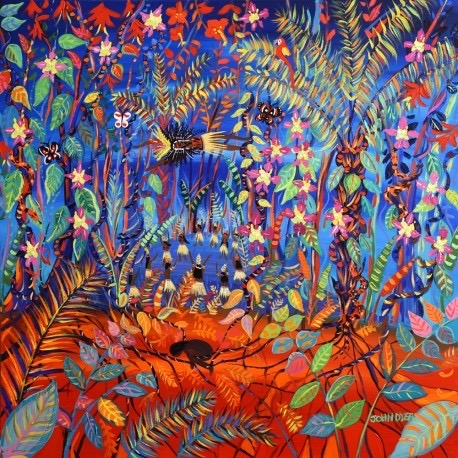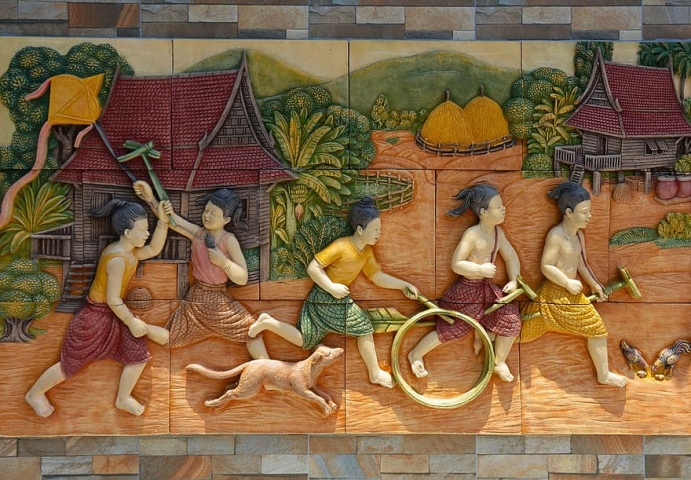The Jurema Mystery
‘Jurema’ back in Brazil is a word full of meanings. From beverage to practice to entity, ‘jurema’ seems to be a word that permeates many different social spheres in the country. Some might not even know what it means, and yet ‘jurema’ might still resonate with familiarity in their ears.
The word, sometimes almost magical sounding, can be found within songs, stories and memories. What exactly is ‘jurema’? Well, it depends on who asks and who is it that decides to answer.
Jurema the tree of 3
To begin with, the easiest way to introduce ‘jurema’ to the unacquainted public is to say it is a tree or rather a variety of different trees with similar properties and cultural associations. ‘Jurema’ which in Tupi means hawthorn, has been used by indegenous populations for centuries. However, since the European invasion, the knowledge about the ‘true’ jurema (if there was ever one) has been lost. What now remains are the cultural vestiges that pinpoint ‘jurema’ as any of a variety of plants belonging to 3 different genera: Mimosa, Acacia and Pithecelobium.
Indeed, like is the case for many plants used by indigenous populations, jurema has become a term that refers to a plant as much as it refers to a practice. Throughout the centuries, via a very turbulent history, the knowledge about jurema and the practices surrounding it have been spread to a multitude of different communities and cultures, which in turn have made a variety of different changes to the understanding of what jurema is or represents. As such, nowadays, jurema may mean entirely different things depending on which group of people is asked.
One of the Juremas
Mimosa tenuiflora, syn. Mimosa hostilis, however, is possibly one of the most popular ‘jurema’ trees on the radar. Be it for its more general use, be it for its high academic interest, this tree has sparked a lot of stories and investigations throughout history. ‘Jurema preta’, as it is commonly named, is widely distributed in the Northeast of Brazil and since the 1930s it has been at the center of many ethnological discussions, together with the multiple other jurema varieties.
The substance that changed everything
During the 1940s, the ethnological interest in the plant grew to become also a chemical interest and in 1946, Lima (PT) managed to perform one of the first alkaloid isolations from the fresh roots of the Mimosa hostilis. There, he discovered an alkaloid which he named nigerina. In 1959, Patcher, Zacharias and Ribeiro, isolated yet another alkaloid with similar properties to that of the nigerina from the bark of the tree, which they established as an indolic derivative, the N, N-dimetiltriptamina (DMT).
N, N-dimetiltriptamina (DMT), is a well known natural and potent hallucinogen which can be used by people to access altered states of consciousness. Throughout many different communities, plants and animals containing DMT have been used during rituals, such as that of Ayahuasca, as a trigger for mystical experiences. As such, the finding that the jurema tree, specifically the Mimosa hostilis tree, contained high levels of DMT led many to think that it was also used in an entheogenic context, as a precursor to spiritual hallucinogenic experiences.
However, until nowadays, despite the many observations of jurema rituals and entheogenic practices, there has been no ethnographic observation of the plant being used as a hallucinogen. For the DMT present in the plant to be effective as a hallucinogen, it must be mixed with some sort of MAO inhibitor. No observation until nowadays, however, has shown any of the different cultures that make use of the jurema plant together with a MAO inhibitor. At most, it might be mixed with alcohol in rituals such as those of catimbó (PT).
Lost knowledge?
The lack of observations of the plant being used as a hallucinogen, nonetheless, does not necessarily mean that the practices had never involved a hallucinogenic component. As is the case for many other cultural elements from different indegenous populations in Brazil, it is possible that the knowledge about the hallucinogenic properties of the plant were lost amidst the European invasion and repression in the years that followed. The idea that there might have been one or more substances that could have been mixed with jurema during rituals in the past is called the Jurema mystery.
The key to the mystery?
Since it was discovered that the jurema plant contains DMT, many speculations have emerged regarding possible plants that could have been used together with jurema in the past. Amongst some of the contenders, which include substantances from passiflora or tobacco to courbaril or ironwood, is the manacá (Brunfelsia uniflora), which has been documented as a potential MAO inhibitor.
Within the indigenous communities of the Northeast of Brazil, region where the most high on DMT Jurema plants can be found, the word cá (common name given to manacá) is sometimes associated with more spiritual meanings. For instance, within the Atikum community, ‘Anjucá’, is the word given to an angelic entity. Within the Pankararu, on the other hand, festivities involving Jurema are called Ajucá, possibly referring to the combination of Jurema (Ju) and manacá (Cá). In fact, in Jurema rituals it is common for those involved to sing to the ‘Old’ or the Anjucá. When asked about the combination of jurema and manacá, nevertheless, people from neither community could recall having done that, despite recognising the manacá as a ‘plant of science’.
Indeed, in current Jurema traditions, Jurema is never really mixed with any substance that could behave as a MAO inhibitor, in fact, the plant that could possibly lead to a slightly more altered state, the black jurema with thorns, is in most cases avoided. Those conducting the ceremonies say that the plant with the thorns makes people go ‘crazy’ and might cause sufferings. The fact that the hallucinogenic effects of the plant are avoided nowadays, however, does not exclude the fact that in the past, as some practices and names suggest, those effects were not experienced during jurema ceremonies. In fact, the act of avoiding the plants that could bring an enhanced hallucinogenic experience can also be perceived as a reminiscent knowledge from the communities’ ancestors.
The ever changing Jurema
Since the establishment of the jurema mystery, ideas regarding whether the hallucinogenic effects of the plant were known or not to different communities and, if they were known, which substances triggered them have been constantly pulling from one opposite to the other. Whereas there are clear indications that, in the past, communities knew about the hallucinogenic effects of the plant, clearly identifying where the knowledge originated and how exactly it was applied might just as well be impossible. Even more so considering the ever transient and mutable nature of the jurema, which has been spread to so many different cultures over so many years.
Indeed, jurema seems to be the type of plant (and practice) that will never stay the same for too long. Since the very first mentions of it until nowadays, jurema has gone from indigenous practices, to urban rituals that mix elements of catholicism with those of indegenous and african origins. At every turn, a new element is added to the jurema practices, which in itself already varies according to different regions and populations. Unsurprisingly, the ‘original’ knowledge of the jurema is easily lost in between so many different modifications and adaptations. Whereas in some communities the knowledge might have been present at some point, in others the knowledge might have never arrived.
Jurema rediscovered
An interesting and recent phenomenon that has been happening since the late 1990s, is the reappropriation of the knowledge regarding the hallucinogenic properties of the jurema by some communities. In 1997, a researcher, then president of Friends of the Forest foundation, called Yatra da Silveira Barbosa traveled to Brazil to learn more about the traditional uses of jurema. Together with two Brazilian anthropologists, Yatra visited some communities who had been making use of jurema during some ceremonies to learn more about their practice. To her surprise, however, she noticed that the communities did not know about the hallucinogenic potential of the jurema plant when mixed with a MAO inhibitor and, as such, decided to share this knowledge with them.
As she traveled through different communities in Brazil, she showed them the effects of the jurema when combined with a MAO inhibitor called Peganum harmala, a combination that she had already been researching for some time. As the communities would experience the effects, a state of unrest would follow where a reinterpretation of the jurema rituals would start to be born. Now, the hallucinogenic properties of the jurema plant were being rediscovered by the communities who had been making use of it traditionally. What these communities would do with such knowledge was left for time to tell.
Since the first travel Yatra did to Brazil, many more jurema cults have originated and a new-age movement involving the plant now exists. At the time of writing this blog, it is still unknown to me whether the communities that were introduced to the hallucinogenic properties of the jurema adopted new practices to make use of these properties or not. Nevertheless, it can be imagined that such rediscovery has at least reshaped, to some extent, their understanding of the plant.
As for the jurema mystery, if previously it was already difficult to untangle the jurema history to better understand its origins, now, this task has become even more difficult. Like no other plant, jurema seems to be a symbol of change and adaptation. In its history, a reflection of the complicated history of the indigenous struggle and the cultural development of a colonized country such as Brazil, where ‘origin’ is a rather complicated topic to be discussed.
Did you enjoy reading this article and do you like to write yourself? We are always looking for people who share our passion for natural products, who can also translate this into great texts. And we have an interesting reward for this. View all information for writers.
Kryptonite
Fly like a bird, thunder like a train, feel like a rocket! Blog User Reports
My Ayahuasca journey
When I was little, I used to tell people I wanted to be an Indian when I was older. When I was big enough, I would build a boat, cross the ocean and l [..]
18-08-2021
9 minutes
Blog User Reports
My Ayahuasca journey
When I was little, I used to tell people I wanted to be an Indian when I was older. When I was big enough, I would build a boat, cross the ocean and l [..]
18-08-2021
9 minutes
 Blog Organic Cannabis Growing
Tips for better outdoor growing
Our Dutch climate sometimes leaves much to be desired. Especially in the autumn it can be rainy and wet in our country. For most photosensitive strain [..]
11-12-2020
8 minutes
Blog Organic Cannabis Growing
Tips for better outdoor growing
Our Dutch climate sometimes leaves much to be desired. Especially in the autumn it can be rainy and wet in our country. For most photosensitive strain [..]
11-12-2020
8 minutes
 Blog CBD
How do I make my own CBD oil?
Recently I was visiting an older man who really does everything himself. He bakes his own bread, chops wood for his self-made stove in his self-built [..]
Blog CBD
How do I make my own CBD oil?
Recently I was visiting an older man who really does everything himself. He bakes his own bread, chops wood for his self-made stove in his self-built [..]













 Nederlands
Nederlands Italiano
Italiano Deutsch
Deutsch Français
Français Português
Português Español
Español Polski
Polski